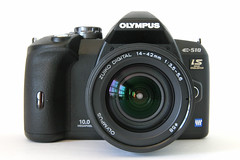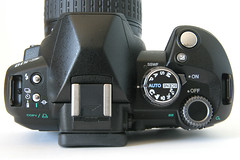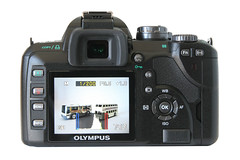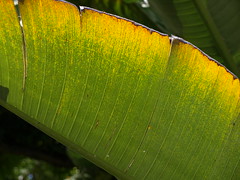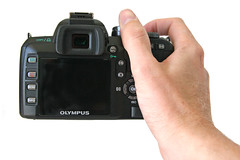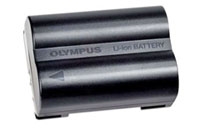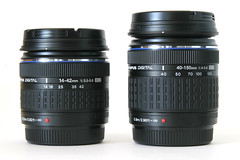Olympus E-510 Guide |
Page updated: August 2007 |
|
This Olympus E-510 Guide will introduce you to this new 10.2 megapixel digital SLR camera from a company that's been pushing the boundaries of SLR technology. They were the first to adopt a new standard - called 4/3 - that uses a sensor with dimensions that are better suited for large-scale prints. They were the first to add a dust control system to their digital SLR cameras (something that's now been adopted by other manufacturers). They were the first to have a digital SLR camera with a live view LCD - one that works just like many compact digital cameras on the market today. And now the E-510 is also a first: it's the only camera to include ALL of these features. Its 10.2 megapixels lets you make high-quality 16x20 inch prints, the dust control system keeps the sensor clean, and the live view lets you compose your photos either through the viewfinder or by using the camera's large 2.5 inch LCD screen. Once you throw in a built-in anti-shake system to the camera's compact frame, you've got an enticing competitor to many of the other 10 megapixel digital SLR cameras currently available. |
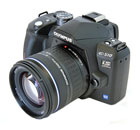 |
Quick Overview
- 10 megapixel sensor - for high-quality 16x20 inch prints
- Compatible with all 4/3 lenses
- 3 photos per second
- ISO settings from 100 to 1600
- Maximum shutter speed of 1/4000th of a second
- 2 times crop factor
- 2.5" LCD
- Stores photos on Compact Flash cards
- 3-area autofocus system
Key Feature
The most notable feature on the Olympus E-510 is its built-in anti-shake system, since it's the only Olympus digital SLR with this feature (as of July 2007).
The anti-shake works with any lens that you attach to the camera - you don't have to buy special stabilized lenses.
You can't see the stabilization working when you look through the viewfinder, but you can see it if you use the camera's live view mode (more on this later).
This system helps you capture photos that would simply not be possible without it. It's most convenient under the following conditions:
- The ambient light is dim
- You can't use a flash
- You're holding the camera in your hands (instead of bracing it with a tripod)
The most common example: taking photos inside museums and aquariums.
The end result without IS is a lot of blurry photos. The two culprits responsible for creating the blur are a slow shutter speed paired with camera shake.
The slow shutter speed is a result of the dim lighting - the camera must keep the shutter open longer to let in more light for a proper exposure. But slow shutter speeds magnify camera shake (when you're holding the camera in your hands) and it's the motion of the camera that causes the blur in your photos.
The image stabilization system works against the shaking of the camera and helps you take clear photos even when the camera is forced to use a slow shutter speed.
But image stabilization is not just to make every photo look crisp and clear - it can also be used to creatively enhance your digital images.
No amount of IS is going to make a fast-moving subject appear clear when the light is dim - only a fast shutter speed can freeze the motion of the SUBJECT.
Since this is the case, you can use it to your advantage to create photos where the background is perfectly clear, but your subject is a blur of motion (without IS the entire photo would come out blurry).
Simply put, there are a lot of different ways to leverage the built-in stabilization system of the E-510.
Who The Olympus E-510 is For
Given its feature set, I'd recommend the E-510 principally for landscape, nature and wildlife photographers.
Here's the rationale:
- The 3-point autofocus system zeroes in quickly on a wide variety of subjects, even ones that trick other autofocus systems
- The live view mode makes it easy to get the camera close to plants and flowers without having to contort your body or crouch down in the mud
- Image stabilization is most useful when taking photos of non-moving subjects, since subject motion can cause blur in your photo even if the camera is steady
- A wide variety of custom metering and white balance settings help ensure that your photos are correctly exposed and that colors are captured accurately
- The compact size and extremely light weight make the camera easy to carry with you into the wilderness
- The dust reduction system ensures that the sensor stays clean, even if you are changing lenses in dusty environments
- The 4/3 format is better suited for making large prints, something that you'll want to do if you capture a fantastic landscape shot
Please don't assume that the E-510 can't take portrait and action shots - it most certainly can. But it's landscape and nature photographers who are going to able to leverage ALL of the features the camera has to offer for maximum effect.
In Comparison
Right out of the gate, it's easiest to compare the Olympus E-510 to its sibling, the E-410.
Identical in many respects, there are two main differences: the E-510 has a significantly deeper handgrip (which makes the E-410 smaller and lighter) and the E-510 has the built-in image stabilization system.
There's about a $100 difference between these two cameras, so if you don't feel the need for stabilization and want the smallest and lightest digital SLR available, then the E-410 is going to be a better bet.
E-510 vs. Sony A100
It's easy to compare these two cameras because in the 10 megapixel digital SLR category, these are the two with the most advanced feature sets.
Both have dust reduction systems and built-in anti-shake. The Sony A100 lacks the live view LCD, but adds on a feature called "eye-start autofocus" where the camera begins to pre-focus when you bring the viewfinder up to your eye.
Here's a quick comparative analysis of these two camera models:
| SONY ALPHA A100 | OLYMPUS E-510 | |
| Megapixels | 10.2 | 10 |
| Max Shooting Speed | 3 photos per sec. | 3 photos per sec. |
| Memory | Compact Flash | Compact Flash |
| ISO | 100 to 1600 | 100 to 1600 |
| Crop Factor | 1.5x | 2x |
| Size | 5.2 x 3.7 x 2.8in. 133 x 95 x 71mm | 5.4 x 3.6 x 2.7in. 136 x 92 x 68mm |
| Weight | 19oz (545g) | 16.2oz (460g) |
| Dust Control | Yes | Yes |
| Image Stabilization | Yes | Yes |
| Live View | No | Yes |
In the end, the winner for me is the Olympus E-510. There are several reasons why:
- The live view LCD incredibly useful for a variety of shooting conditions
- Olympus has a longer history of digital SLR camera fabrication than Sony, who appears to be working out some kinks with their first SLR (according to independent user reviews)
- The Olympus dust reduction system has been around longer than any other, and appears to be the most effective at reducing and eliminating sensor dust
- Sony is just getting into the world of camera lenses, whereas Olympus has been developing and enhancing their 4/3 lenses for some time
E-510 vs. Other 10 Megapixel SLRs
There's no doubt about it: the E-510 has a lot of serious competition.
It's not only up against the Sony, but also the top-selling Canon Rebel xTi, the highly-regarded Nikon D80, the entry-level D40x and the top-rated Pentax K10D.
The most notable difference between these cameras comes out when you consider the "extra" features that each one offers.
The table below shows that the Olympus E-510 is the only camera with every single one of these additional features:
| STABILIZATION | DUST CONTROL | LIVE VIEW LCD | |
| Canon xTi | X | ||
| Nikon D40x | |||
| Nikon D80 | |||
| Olympus E-510 | X | X | X |
| Pentax K10D | X | X | |
| Sony DSLR-A100 | X | X |
Another notable difference between these cameras is the number of autofocus points:
| AF POINTS | |
| Canon xTi | 9 |
| Nikon D40x | 3 |
| Nikon D80 | 11 |
| Olympus E-510 | 3 |
| Pentax K10D | 11 |
| Sony DSLR-A100 | 9 |
It's important to point out, however, that more autofocus points does not necessarily mean the autofocus is more precise. While multi-point AF systems are quite helpful when tracking off-center subjects, they can also get confused when there are a lot of possible subjects in the frame to focus on.
If you're looking for something simple and precise, the 3-point system in the E-510 might be just what you need.
There's also the issue of weight and size. There's not a huge amount of variation in the weight and dimensions of many of these camera bodies, but remember that these are the cameras without lenses.
One of the key benefits of the 4/3 system is that the lenses are significantly lighter and smaller than other lenses with the same focal length.
This means that the E-510 with its 14-55mm lens takes up very little space in a small camera bag - leaving you with plenty of room for camera accessories (a seemingly inevitable side-effect of owning a new digital SLR).
How It Works
In Use
One nice aspect about this camera is that even though it packs in a lot of features, many of those features are easily accessible from buttons on the camera's back.
I put the camera through its paces for this Olympus E-510 Guide, and found that I did not have to refer to the manual all that much to change settings like ISO, white balance and metering. Image stabilization and live view modes are also easy to activate with one-touch buttons.
The features that aren't associated with a one-touch button are also instantly accessible via an innovative LCD display that lets you make quick adjustments to all of the following settings from one simple screen:
| FEATURE | SETTINGS |
| ISO | 100, 200, 400, 800, 1600 |
| White Balance | Auto, Daylight, Shade, Overcast, Tungsten, Fluorescent 1, Fluorescent 2, Fluorescent 3, Manual, Kelvin |
| Flash Modes | Auto, Red-eye reduction, Fill flash, Flash off, Slow synch red-eye reduction, Slow synch (1st curtain), Slow synch (2nd curtain), Manual full, Manual 1/4, Manual 1/16, Manual 1/64 |
| Color Modes | Vivid, Natural, Muted, Monochrome |
| Metering Mode | 49 areas, Center-weighted, Spot, Spot Highlight, Spot (Shadow) |
| AF Points | All three, Left, Center, Right |
| Autofocus Modes | Single (S-AF), Continuous (C-AF), Manual (MF), Single with manual (S-AF+MF), Continuous with manual (C-AF+MF) |
| Photo Modes | One-shot, Continuous, 12 second timer, 2 second timer, Remote, 2 second remote |
| Card Type | Compact Flash, Microdrive, xD Picture Card |
| Image Quality | HQ, SQ, RAW+SHQ, RAW+HQ, RAW+SQ, RAW, SHQ |
Paired with the 14-55mm lens (part of the typical E-510 camera package), this camera is incredibly compact and light. Not many other digital SLR cameras will fit nicely into the palm of your hand with a lens attached, but this one does.
Despite its diminutive size, the E-510 feels quite sturdy and you don't get the feeling that it would suffer too much from being dropped - something that I certainly did not try out for this guide.
Live View
I realized quite early on that one of the features I wanted to present in detail for this Olympus E-510 guide is the live view LCD.
While it would be quite easy to go on at length about the variety of ways that you can use this feature to capture photos, I'll try to limit my commentary to some of the standout aspects of the live view mode.
For those of you still scratching your heads about what a "live view LCD" is, here's the quick introduction:
A live view LCD lets you compose photos without looking through the camera's viewfinder. It's how virtually every compact digital camera works.
The big surprise for many making the transition from compact point-and-shoot to digital SLR is that the vast majority of digital SLR cameras DO NOT have this live view mode. In fact, there are only a limited number of live view digital SLR cameras out there, and the E-510 is one of them.
First and foremost, the live view LCD lets you take photos with the camera at arm's length. This helps you capture images with unique points of view.
For example, some of the photos that I took for this Olympus E-510 guide were flowers in my back yard. For one of the shots, I leaned way out over our deck railing, and twisted the camera around to capture an image of a rose.
While I could certainly have done the same using an SLR without live view, there's no way that I would be able to look through the viewfinder, and I would have to compose the photo "blind" and just hope that it turned out.
A second fringe benefit of the live view sensor is instant feedback about your exposure that comes in two forms: the brightness on the LCD and a real-time histogram.
First, you're able to see how changing camera settings either lets more or less light into the camera. If you widen the lens aperture or slow down the shutter speed, the live image on the LCD gets brighter. If you narrow the lens aperture or increase the shutter speed, the image gets darker.
This instant feedback is quite helpful for anyone just learning the manual controls of their SLR (and I DO recommend you learn how to use the manual controls) since you can see the immediate effect of an adjusted camera setting.
The second form of instant feedback is a bit harder to explain.
Most digital SLR cameras allow you to see a histogram of the photo that you just took. In brief, a histogram is a visual display of the light and dark elements in a photo. Once you know how to read a histogram, it provides you with valuable information about whether or not your photo is correctly exposed.
The special quality of the live view display on the E-510 is that is also provides you with a live view histogram. This animated display not only shows you when your photos are going to be over or under-exposed, it also clearly shows you how pointing the camera at different subjects (predominantly light vs. predominantly dark) changes the shape of the histogram - and therefore, how it will affect the final image.
I'll be the first to admit that people just getting used to their new digital SLR camera aren't going to be leveraging the live view histogram mode very much.
But the important thing is that the feature is there, and as your photographic skills progress and you want to improve the quality of the photos you take, the live view histogram will be there to help you out.
Image Magnification and Live View
A feature of the E-510 that's related to the live view mode is the ability to magnify your subject on the camera's LCD.
Anyone who's deeply into flower and macro photography should be immensly pleased.
Increasing the size of the subject on the E-510's large 2.5 inch LCD display helps you make sure that it's perfectly focused.
In some cases, this magnified display is an easier way for you to check focus than peering through the camera's viewfinder.
When using this magnified mode, it helps to have the camera attached to a tripod to keep it steady, but you can also activate the camera's image stabilization to prevent the LCD image from jumping around.
Limitations of Live View
Now that I've touted its benefits, I'd also like to make you aware of one of the limitations of the live mode view: it's not for action photography.
Part of the reason for this has to do with how a digital SLR is built: a mirror sits in front of the camera sensor to direct the light passing through the lens up to the viewfinder.
When you switch to live view mode, the mirror snaps up out the way so the sensor can be exposed to light.
This means two things:
- The camera won't autofocus when you press the shutter release halfway (you can autofocus by pressing a button the camera's back)
- The viewfinder is blacked out and cannot be used until you switch out of live view mode
For each photo you take in live view mode, the camera must perform four actions:
- Flip the mirror down
- Engage the autofocus
- Take the photo
- Flip the mirror up
In case it's not obvious, performing these four steps takes quite a bit of time.
This is why the live view mode isn't going to be terribly helpful if you try to use it for action photography, and why I principally used it to take photos of static subjects.
It's not that the E-510 can't take action photos - it certainly can. I just don't want you to be disapponted if you imagined you could use the live view mode to take photos of your daughter's soccer game.
See Live View in Action
Built-in Image Stabilization
Built-in image stabilization (IS) is a fantastic feature for low-light and telephoto lens photographers.
In both cases, the shaking of the camera is magnified, and results in photos that look blurry and unfocused.
The IS system in the E-510 counteracts camera shake, and helps you capture clearer photos when the light is dim or when you're using extreme telephoto lenses (200+ millimeters).
The especially nice part is that the IS works in conjunction with the live view LCD so you can see it going to work (on most other digital SLRs with built-in IS you just have to trust that it's doing the job.
With the E-510, first you activate the live view LCD, then you press and hold the IS button to activate the stabilization.
The results are immediate, and help you clearly see just how the IS system is stabilizing away even when you're using the viewfinder to compose your photos.
You might not think you'd use the image stabilization system all that much, especially if you don't fancy taking lots of photos in dim light.
But consider this: stabilization is especially helpful when you use the camera in live view mode.
Any idea why?
The reason is that when you use the live view mode, you hold the camera differently.
My common stance when taking photos with a viewfinder is this: right hand on the camera grip, left hand on the lens, and the viewfinder pressed up to my forehead.
But when I switched to live view mode, I'd tend to hold the camera only with my right hand at arm's length.
In case it's not obvious, here's the problem: when you take photos holding the camera out from your body, the amount of camera shake increases substantially.
This is why the E-510's stabilization is even more useful than it is on other cameras without the live view mode.
Color
The color and clarity of the images produced by the E-510 are what you'd expect from a 10 megapixel camera in this price range - exceptional.
And if you find that the color capture is not to your liking...you can adjust it.
The Olympus E-510 has three primary color capture modes: Neutral, Vivid and Muted. For each color mode, you can further refine the Contrast, Sharpness and Saturation of the image.
While you can fiddle around with the settings to your heart's desire, the default setting already produces photos that are vibrant.
With some other digital SLR cameras I wasn't satisifed with the color and tone of the images the camera captured by default and had to make adjustments.
The E-510 produced images with plenty of "wow" right out of the box.
Black and White (Monochrome)
Don't worry all of you monochromatic folks - the E-510 is not just about color.
It also includes a wide variety of monochromatic options, where black and white is just one of them.
For the pure black and white mode, you have the option to captures images as if there was a colored filter on the lens. Black and white film enthusiasts used colored filters to enhance certain elements of a black and white photo.
On the sample image below, just click on the filter name to see its effect.
| FILTER | EFFECT | SAMPLES |
| Yellow | Darkens blue sky and separates sky from clouds | |
| Orange | Lightens red tones to soften freckles in portraits | |
| Red | Creates very dark skies and makes red tones white | |
| Green | Lightens trees and foliage and corrects skin tones |
You also have the option to add a color tone to the entire image (which is NOT the same as using a color filter on a black and white image).
The color tone "tints" your entire photo with the color of your choice:
Image Review
The E-510 has two nice "extra" features that make finding and sharing your photos a breeze.
The first is a calendar mode: in addition to displaying all of your images as small thumbnails, the E-510 can also bring up a calendar display to show you photos based on the date they were taken.
If you want to review photos for any given day, you can quickly jump to that day in the calendar.
While it's nice that you're able to quickly find photos stored on the camera's memory card, that wouldn't matter too much unless you wanted to share the photos with others.
With the E-510's slideshow mode, you can do just that.
All you have to do is plug the camera in to a television (the connecting cord is included), select the menu setting for slideshow mode and off you go.
The camera steps through each photo on the memory card in sequence so you don't have to keep pressing buttons to advance to the next image.
Batteries
The E-510 uses a rechargeable Lithium Ion BLM-1 battery.
Don't think that you can just take it out of the box and start snapping photos though - the initial charge takes up to 5 hours.
The good news here is that once the battery is fully charged it lasts a long time, even if you're using the live view LCD a lot (which eats up power faster).
Mine went for a full three weeks of fairly continuous daily photography sessions.
If you're looking to get a backup battery, I recommend that you go with another Olympus BLM-1. While there are other third party batteries that cost a lot less, they do not appear to have the same longevity as the ones that are made by Olympus.
Advanced Features
One of the nice - and simultaneously daunting - aspects of the E-510 is the sheer number of ways the camera allows you to customize the way it captures photos.
Many digital SLR cameras let you bracket exposures: three photos in succession, where one is exposed correctly, one is over-exposed and one is under-exposed.
The E-510 allows you to bracket exposures, but it also allows you to bracket white balance (a far less common feature).
All you have to do is adjust one of the menu settings, and instead of taking one photo per shot the camera takes three. Each one of the three photos has a different white balance applied.
The built-in flash on the E-510 also has something unique: the ability to manually set the output power of the flash.
On many other digital SLR cameras there are several flash modes - like red-eye reduction and slow sync - but manual flash control is rare.
You can set the E-510's flash output to full, 1/4, 1/16 and 1/64. This last one is ideal when you just need a little bit of flash to fill in the shadows on a sunny day.
Finally - and I must admit that this is a feature that is just plain fun - the camera rotates the image displayed on the LCD when you change the orientation of the camera. This means that you can flip the camera up on its side to see your portrait photos full-screen.
Lenses
I actually used two different lenses for this Olympus E-510 guide:
- 14-42mm f/3.5-5.6
- 40-150mm f/4.0-5.6
They cover a nice range from wide-angle (for those landscape enthusiasts) to the mid-telephoto range (better for portraits).
I can keep this portion of the guide simple: these are exceptional kit lenses.
Many other "kit" lenses that I have used on other digital SLR cameras feel cheap, affect the image quality, or result in noticeable distortion in the photos you take with them.
By contrast, the photos I captured with these two lenses were crisp, clear, and distortion-free.
I even took some photos that make even minute lens flaws noticeable: the side of buildings with repeating horizontal and vertical lines. The result? Straight lines throughout and crisp edges.
There's something else about these lenses that bears repeating: since they are designed with the 4/3 sensor in mind (which is smaller than other SLR camera sensors) theses lenses are exceptionally compact and light.
Even extended to their telephoto lengths, they don't draw attention to you and your camera (great for travelers who don't want to advertize their cameras).
Both lenses come with matching lens hoods (to prevent lens flares), which is a nice addition for photographers who work in a lot of direct sunlight.
If you're new to the Olympus digital SLR camera line (or new to all digital SLRs for that matter) then I would definitely recommend that you get the two-lens kit for the E-510.
It provides you with a greater zoom range to work with, and is a minor additional cost relative to the base price of the camera without any lenses at all.
The Pros and Cons
| Pros | Cons |
|
|
Olympus E-510 Photo Samples
Olympus E-510 Video Tour
See the Olympus E-510 in action and find out more about the camera's features and settings in this quick video tour (duration: about 7 minutes).
Price Analysis
The Olympus E-510 is competitively priced with the other 10 megapixel digital SLR cameras.
While it's not at the low end of the 10 megapixel price range, it also includes several more features than the other cameras. Many of the other cameras are also older, and have already benefitted from several price reductions.
I don't typically recommend that you buy both camera and lens as part of a kit, because I've found that most kit lenses are low-quality.
However, I have no trouble at all recommending the E-510 kit lens (or lenses) since they do not impact image quality in any noticeable way.
Since this is the case, you can save yourself some money by finding a good package for the E-510, and get both camera and lens at the same time.
| CAMERA PACKAGE | AVG. COST | COMPARE PRICES | |||
| E-510 body only (no lenses) | $ 495 |
|
|||
| E-510 with 14-42mm lens | $ 585 |
|
|||
| E-510 with 14-42mm and 40-150mm lenses | $ 675 |
|
Accessories
As is true with many other digital SLR cameras, buying the camera and lens is just the tip of the iceberg.
There are a wide variety of additional accessories that can be paired with the E-510 that will expand your photographic capabilities and clear out your bank account.
Memory Card
The E-510 uses three types of memory cards: Compact Flash, xD Picture Card (a proprietary Olympus card) and Microdrive.
I recommend two things with regard to the memory card:
- Get at least a 2GigaByte card to begin with
- Get a card with high-speed data transfer
The reason for this is that the 10 megapixel files produced by the E-510 not only eat up a lot of space on your memory card, they also take a LONG time to transfer from memory card to computer.
If you don't want to be waiting around for 30 minutes every time you take photos with your E-510, a card with a fast data transfer rate is ideal.
I use the SanDisk Compact Flash cards myself because they are inexpensive and exceptionally reliable.
Remote Trigger
There are two types of triggers that you can use to take photos with the E-510 without actually touching the camera (great for photos with VERY slow shutter speeds and any shot that you'd like to be in yourself).
The RM-UC1 trigger is physically attached to the camera via a cable, while the RM-1 is wireless - allowing you to stand in front of or away from the camera if you so desire.
External Flash
If you want to get more power out of your flash than the built-in unit provides, or want to bounce the flash off ceilings and walls (which creates a softer light) then you're going to need an external flash unit.
The big kahuna is the FL-50 (available at Amazon and Adorama), and it includes a tilt and swivel head along with automatic and manual flash modes.
This flash offers what Olympus calls "Super FP Mode", which allows you to use fast shutter speeds in conjunction with flash. For example, if you use the built-in flash on the E-510, the fastest shutter speed the camera can use is 1/180th of a second.
But if you attach an FL-50 and set it to Super FP Mode, you can use shutter speeds all the way up to 1/4000th of a second.
This is a better solution for anyone who takes action photos in dim lighting conditions and needs some additional light from on-camera flash.
The only problem is that the FL-50 will run you about $370 - a full-featured flash comes with a high price tag.
If you still want to gain some of the benefits of external flash but aren't willing to pay half the price of your camera to get it, then an alternative option is the FL-36 (available at Amazon and Adorama).
While the FL-36 is not as powerful as the FL-50, it is significantly more compact and lightweight, and can run on just two standard AA batteries.
With a price tag around $170, the FL-36 will improve your flash photography without breaking your bank.
Links and Additional Resources
- E-510 Information on the Olympus USA Web Site
- E-510 Instruction Manual and Quick Start Guide
- E-510 Frequently Asked Questions
- E-510 Firmware Update Instructions
Learn how to use all of the features of your Olympus E-510 and dramatically improve the photos you take with five online digital SLR lessons
| Digital SLR Home | Other Camera Guides |


